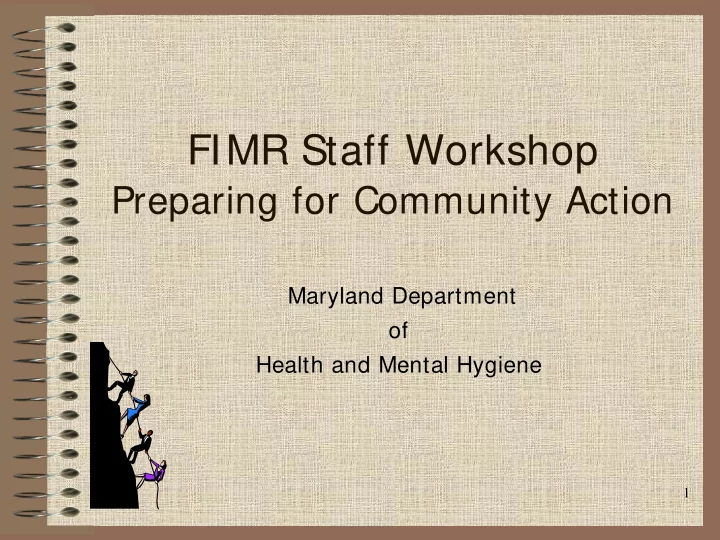

FIMR Staff Workshop Preparing for Community Action Maryland Department of Health and Mental Hygiene 1
CAT: What is it? Community Findings Action Recommendation s The Community Action Team hears findings from the Case Review Team, and makes recommendations for change. The team is made up of community leaders who can help create this change. 2
Community Action: Sources of Information • Case Level Data • Review Team Findings • Population Data • Research Literature 3
Building a Successful CAT • A successful CAT should consist of a diverse group of individuals representing organizations and institutions in the larger community. • Membership should include those who are influential or able to mobilize resources on behalf of their organizations, and are committed to change. • It is important that every member be an equal partner in the process. 4
Separate Teams • Advantages: Can tailor staffing and membership to skills required CAT group may be able to carry out an activity with a single focus – from resource generation to conducting activity. 5
Separate Teams (cont.) • Disadvantages: – Must create communication links between the two groups • Participation of one or more staff or members on both teams • Shared minutes and action plans, etc. – May pose a burden on staff or members to attend multiple meetings and follow-up – May be difficult to keep case review findings and recommendations linked to community action 6
Potential Members Mayor or County Executive Child Welfare Agencies Religious Leader Substance Abuse Services Business Leader Mental Health Services Chamber of Commerce Housing Authority MCO/HMO Representative Transportation Authority Medicaid EMS Hospital Administration Bereaved Parents Group Social Workers WIC Supervisor 7
Structure of the Community Action Team •Structure: •Facilitator •Staff •Abstractor •Interviewer •Case Presenter •Recorder 8
Structure of the CAT: Depends on the Action •Facilitator’s role: •Observes group process and intervenes as needed to assist the group in meeting its goal of effective case review •Encourages full participation •Establishes ground rules and procedures •Promotes a climate of openness, trust, and cooperation •Provides structure and focus to the discussion 9
Structure of the CAT, cont’d • Consider applying the following facilitating techniques: – Set ground rules – Structure the discussion – Try coaching, modeling – Gate-keeping – Clarifying, eliciting consensus 10
Structure of the CAT, cont’d • The group discussion should be: – Kept on-track – Focused on systems issues – Respectful of members and case subjects – Consistent from case to case • Group dynamic problems that may arise: – Poor or late attendance – Side discussions – Uneven participation; dominance – Hierarchy – Inability to focus – Same issues keep arising 11
Structure of the CAT, con’t • How to correct these problems: – Rearrange the room or relocate to another room – Assign seating – Change membership – Training – Conflict management – Use different techniques: • FIVE HATS 12
Care and “Feeding” of Members • Keep members active • Show appreciation for their time and effort • Serve refreshments at meetings when possible • Public recognition of accomplishments 13
Maintaining a Link to Case Reviews • Important to maintain active communication between the Case Review and Community Action Teams. • Easiest way is to have at least one member of the Community Action Team also participate in the case review process. • FIMR action priorities emerge from case reviews and translating the findings into action requires some shared knowledge of both processes. 14
Making a Difference By Taking Action Step 1: Step 2: Develop priorities Identify key based on FIMR and community and CFR findings and institutional partners recommendations to engage in efforts. 15
Making a Difference By Taking Action Step 3: Step 4: Identify means to Facilitate implement activities implementation of to improve systems activities. of care. 16
Examples of Community Action in Maryland Bereavement Support Developed protocol for hospitals to follow in event of perinatal loss or very low birth weight birth. Pre-Term Labor Prevention Educated pregnant women on the signs of pre-term labor by distributing magnets and wallet cards 17
Examples of Community Action in Maryland (cont.) Back to Sleep A safe sleeping campaign and other care takers (Grandparents) reminding them that babies sleep safest on their backs ABC Another safe sleeping initiative reminding parents that babies sleep safest Alone, on their Backs, and in a Crib 18
Examples of Community Action in Maryland (cont.) Post-partum Health Encouraged local maternity services to make post- partum appointments for mothers with doctors’ orders. Encouraged WIC, Healthy Families and IPO staff to provide lactation consultation. Substance Use Cessation Funded nicotine patches for pregnant women and their families. Provided addiction screening tools to pediatricians, school nurses, and obstetricians. 19
Recommend
More recommend